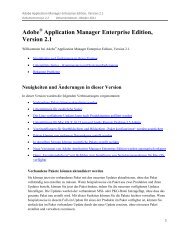XMP Specification Part 3: Storage in Files - Adobe
XMP Specification Part 3: Storage in Files - Adobe
XMP Specification Part 3: Storage in Files - Adobe
You also want an ePaper? Increase the reach of your titles
YUMPU automatically turns print PDFs into web optimized ePapers that Google loves.
AVI files can conta<strong>in</strong> native metadata. See detail of how these are reconciled with <strong>XMP</strong> <strong>in</strong> 3.3.2, “Native<br />
metadata <strong>in</strong> AVI”.<br />
The Library of Congress Digital Preservation project has specific AVI <strong>in</strong>formation at: http://<br />
www.digitalpreservation.gov/formats/fdd/fdd000059.shtml This <strong>in</strong>cludes a l<strong>in</strong>k to OpenDML extensions at:<br />
http://www.morgan-multimedia.com/download/odmlff2.pdf<br />
2.2.3 FLV (Flash® Video)<br />
FLV is designed to carry synchronized audio and video streams, and is used to deliver video over the Internet<br />
us<strong>in</strong>g <strong>Adobe</strong> Flash Player (<strong>in</strong> versions later than 6). Flash Video content may also be embedded with<strong>in</strong> SWF<br />
files.<br />
FLV is a fairly simple format, with a strong orientation to stream<strong>in</strong>g use. It consists of a small file header then a<br />
sequence of tags that can conta<strong>in</strong> audio data, video data, or ActionScript data. For FLV version 1, each tag<br />
beg<strong>in</strong>s with an 11-byte header:<br />
• UI8 tag type: 8 = audio tag, 9 = video tag, 18 = script data tag<br />
• UI24 content length <strong>in</strong> bytes<br />
• UI24 time: low-order 3 bytes<br />
• UI8 time: high-order byte<br />
• UI24 stream ID<br />
This is followed by the tag's content, then a UI32 "back po<strong>in</strong>ter" which is the header size plus the content size.<br />
A UI32 zero is placed between the file header and the first tag as a term<strong>in</strong>ator for backward scans. The time <strong>in</strong><br />
a tag header is the start of playback for that tag. The tags must be <strong>in</strong> ascend<strong>in</strong>g time order. For a given time it is<br />
preferred that script data tags precede audio and video tags. Each audio or video tag typically conta<strong>in</strong>s one<br />
frame of data.<br />
For metadata purposes, only the script data tags are of <strong>in</strong>terest. Script data <strong>in</strong>formation becomes accessible to<br />
ActionScript at the playback moment of the script data tag through a call to a registered data handler. The<br />
content of a script data tag conta<strong>in</strong>s a str<strong>in</strong>g and an ActionScript data value. The str<strong>in</strong>g is the name of the<br />
handler to be <strong>in</strong>voked, the data value is passed as an ActionScript Object parameter to the handler.<br />
A variety of native metadata is conta<strong>in</strong>ed <strong>in</strong> a script data tag with the name onMetaData. This conta<strong>in</strong>s only<br />
<strong>in</strong>ternal <strong>in</strong>formation such as duration or width/height, noth<strong>in</strong>g that is user- or author-editable, such as title or<br />
description. Some of these native items are imported <strong>in</strong>to the <strong>XMP</strong>; none are updated from the <strong>XMP</strong>.<br />
2.2.3.1 Placement of <strong>XMP</strong><br />
<strong>XMP</strong> is embedded <strong>in</strong> FLV as a script data tag with the name on<strong>XMP</strong>Data. It must be placed at time 0 and must<br />
have stream ID 0. It should be after any time 0 onMetaData tag, and before any time 0 audio or video tags.<br />
Software look<strong>in</strong>g for exist<strong>in</strong>g <strong>XMP</strong> must exam<strong>in</strong>e all time 0 tags. One cannot presume that all third party<br />
modifiers of FLV files will preserve onMetaData, then on<strong>XMP</strong>Data, then audio/video order<strong>in</strong>g.<br />
The data value for on<strong>XMP</strong>Data is an ECMA array. Standard serialized <strong>XMP</strong> is <strong>in</strong> an array item with the key<br />
liveXML; the data of this item is an ActionScript str<strong>in</strong>g conta<strong>in</strong><strong>in</strong>g a normal UTF-8 <strong>XMP</strong> packet (<strong>in</strong>clud<strong>in</strong>g<br />
padd<strong>in</strong>g). The ActionScript str<strong>in</strong>g can be a short or long str<strong>in</strong>g as appropriate.<br />
The formal specification for SWF and FLV is Macromedia Flash (SWF) and Flash Video (FLV) File Format<br />
<strong>Specification</strong> Version 8. This is available at: http://www.adobe.com/licens<strong>in</strong>g/developer<br />
NOTE In the public FLV specification version 8 and earlier, there are errors <strong>in</strong> the descriptions of SCRIPTDATAOBJECT,<br />
SCRIPTDATAOBJECTEND, SCRIPTDATAVARIABLE, SCRIPTDATASTRING, SCRIPTDATALONGSTRING,<br />
SCRIPTDATADATE, ECMA arrays, and strict arrays.<br />
28 ©<strong>Adobe</strong> Systems Incorporated, 2010

















